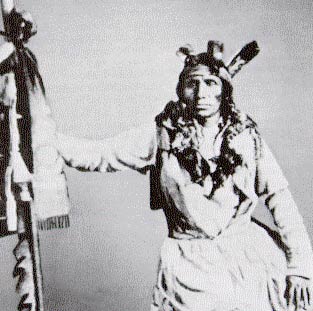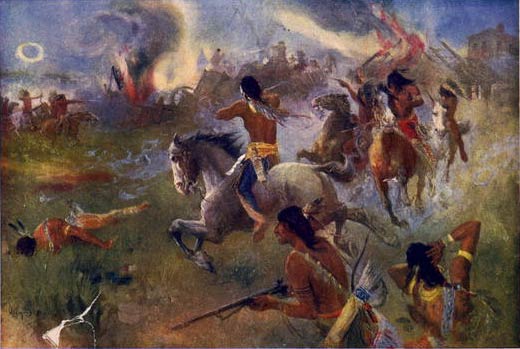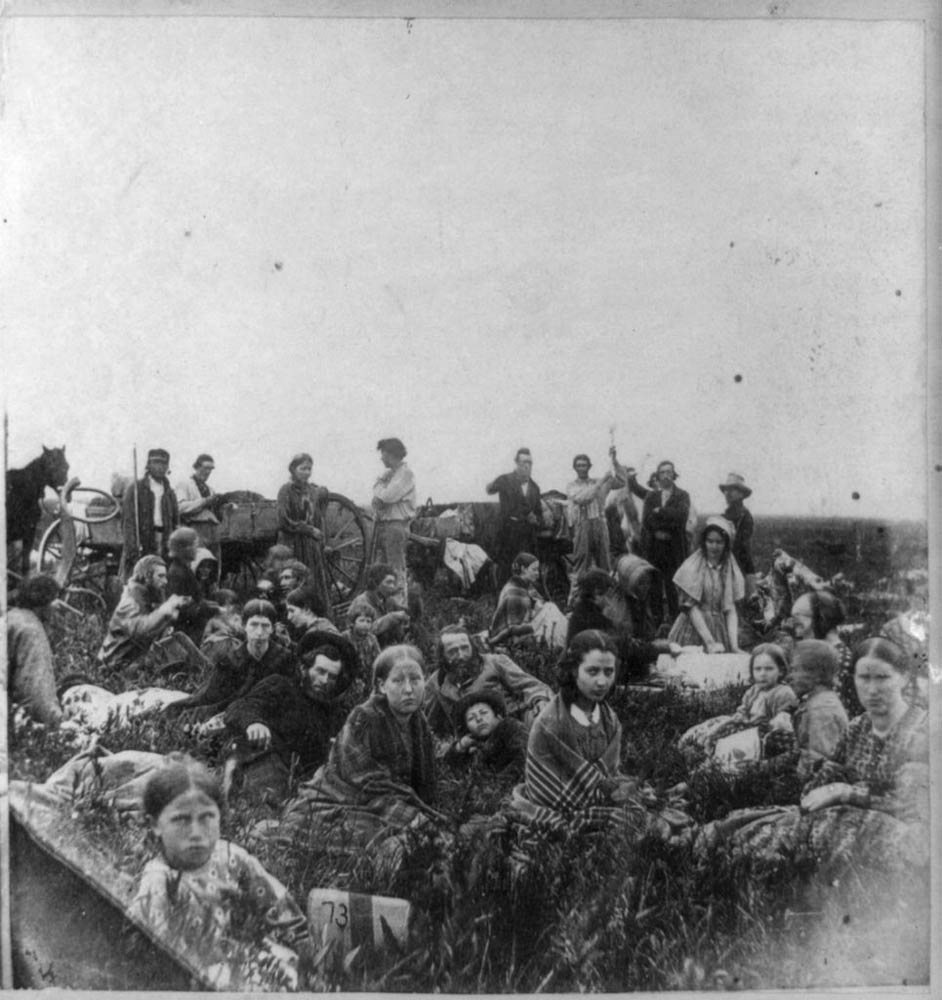When the state of Minnesota recently celebrated its 150th Anniversary of statehood in 2008, this bitter war between white settlers and Native Americans was revisited in depth in the media, public forums and observances. It’s clear that many of the old wounds inflicted so many years ago still cause pain.
The Dakota War of 1862, (or the Sioux Uprising) began in a southern area of Minnesota near the present city of Mankato. In a location near the Minnesota River, a hunting party of four Dakota Sioux killed five white settlers. It was the spark that flared a wide scale decision by the Dakota Sioux to bring full-scale war against the United States.
Broken Treaties
The first killings of settlers by the Sioux were the culmination of more than 10 years of frustration beginning in 1851, when the United States government signed two treaties with the Dakota Sioux. These were the Treaty of Traverse des Sioux, signed on July 23, 1851, and the Treaty of Mendota, signed on August 5, 1851.
Both treaties were a raw deal for the Native Americans, but decades of conflict with white settlers had depleted the numbers, strengths and resources of Indian nations in that region. They had little choice but to make peace and accept the terms of the treaties – which ceded vast areas of Indian territory to the U.S. in exchange for money and supplies.
The Dakota Sioux were relegated to an area by the Minnesota River that was about 20 miles wide, and which ran up and down the river for about 150 miles.
This would have been bad enough, except that a combination of actions by U.S. Senate and local Indian agents immediately began to violate the terms of the two treaties. For one, the Senate eliminated Article 3 of the one of the treaty unbeknownst to the Sioux. This reduced considerably what they were to receive under the terms of the original agreements.
Cheated on Money and Supply
Furthermore, the money and supplies they were to receive often got siphoned off by Indian agents, bureaucrats and various middlemen – in effect, the Dakota Sioux had not only given up 98% of the land that had once belonged to them, but they were now getting cheated out of what little compensation they had been promised. All this, and settlers continued to encroach upon land that belonged to the Dakota.
The result was that living conditions on the Indian Reservation became unbearable. There was starvation, poverty and hopelessness. And so in the summer of 1862 anger among Sioux warriors flared into violence. After the first five settlers were killed, the Dakota met in a war council wherein they agreed to prosecute a full-scale war on the whites. The goal was to drive them out of Minnesota.
The Beginning of the War

Chief Little Crow
The leader of the Dakota Sioux was Little Crow. It was he who had negotiated the Traverse and Mendota treaties. On August 18, a day after the first five settlers were killed, Little Crow led a small force to attack the Lower Sioux Redwood Agency, killing at least one person there, but unwittingly allowing most of the people to escape across the Minnesota River.
The escapees of the Redwood Agency attack alerted the Minnesota volunteer military forces who mounted an attack on Little Crow’s position there. The Minnesota army volunteers were defeated in what is known as the Battle of Redwood Ferry, which killed 24 Minnesota militia men.
This event triggered off a series of raids and attacks on white settlers in a much wider area along the Minnesota River. Numerous settlers were killed and others driven off their land. Small towns and cabins were burned and farm sites were raided for food and belongings. This begin a string of victories of the Dakota Sioux warriors. They sacked a number of larger towns, including New Ulm, Minnesota, and conquered several forts in the region.
The Spread of the Rebellion
The fighting in the south of Minnesota sparked off other conflict around the state, both in the far north and even in what is now Manitoba in Canada.
The fact that the Dakota Wars began during the Civil War purchased the rebelling Indians some time. Military men and supplies were heavily committed to the national war effort. Nevertheless, local Minnesota militias with the help of federal troops eventually organized a large, well-armed force to counter the Dakota uprising.
Quick Conclusion
The first large-scale fighting began in late September 1862. A well-equipped army consisting of elements of the 3rd, 4th, 6th, 9th and 10th Minnesota Volunteer infantry Regiment met a force of the Dakota Sioux in Yellow Medicine County. Here was fought the Battle of Wood Lake, which was an utter defeat for the Sioux. Armed with a 10-inch cannon and superior firepower, the Minnesota volunteers were able to inflict heavy casualties on the Sioux, including the death of Chief Mankato, who was killed by a cannon ball.
By the time whites and the Dakota engaged in the Battle of Wood Lake, their uprising had been about a month old and already running out of steam. The Dakota Sioux surrendered and ended their conflict on Sept. 26. Thus, the Dakota War of 1862 lasted scarcely more than a month. It is estimated that 800 white settlers were killed during the month.
Terrible Aftermath
What happened in the aftermath of the war is as much a source of ongoing bitterness as the conflict itself. Hundreds of the Dakota involved in the war were rounded up and imprisoned and tried in military tribunals. More than 300 of them were convicted of murder and rape and were given a death sentence. On December 26, 1862, the day after Christmas, 38 Dakota Sioux were hung in Mankato.
The 38 hangings are still the largest mass execution in U.S. history. The mass hangings were conducted in public and all on a single platform. The bodies of the dead were buried in a trench near the Minnesota River.
Many of the other Dakota warriors who escaped hanging were imprisoned or deported to other states. About one-third of those imprisoned died during their incarceration under extremely harsh conditions.
After the war, all remaining Dakota Sioux in Minnesota were deported to other states, most of them to South Dakota, North Dakota and some to Nebraska and Iowa. Chief Little Crow survived the war and the military tribunal, but was killed about a year later in an armed skirmish with a Minnesota settler.

